May
22 2008 chase
Departed KC at 830am with
a rough target of Utica in westcentral KS. Numerous supercells were
likely to develop over the high plains as large scale ascent
overtook the dryline.
With a deep parent surface low, strong isallobaric adjustments would allow for
relatively brisk and backed 0-1 km agl flow over western KS
and far southwestern NE...
which is generally where the best tornado potential would exist. I looked
closely at the 12Z data, still debating over whether to
mess with the surface warm front
close to the NE border... where low-level winds would have the strongest
easterly component, contributing to hallacious shear amidst
CAPES AOB 1500 J/kg.
A little farther south, short-term model guidance was not agreeing on how
significant the low-level shear would remain in an environment
with much stronger
instability (CAPES around 3000 J/kg). Based in part on the timing of when
individual storms chose to produce tornadoes (and my own indecision),
the main tornadic show I ended up
chasing was indeed farther south into the warm sector. The 00Z DDC RAOB
ultimately showed a perfectly sufficient (bordering on large!)
low-level sr-hodograph,
which may actually be a slight underestimate of the shear available for my storm
(~80 miles north of DDC). I'm thus a little surprised that it
wasn't quite as productive
as its friends farther northwest (each of which began tornadoing 15 minutes
after I'd left them). Still, I can't complain about what I observed,
as it was quite a treat
and my best daylight tornadoes to date since 09/21/06.
|
Images (click for
larger version) |
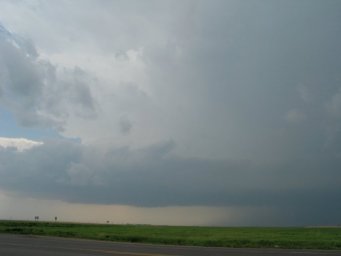 |
327 pm: strengthening updraft with
inflow band west of Dighton KS
|
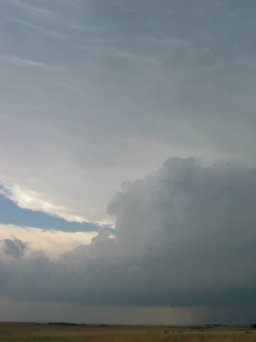 |
337 pm: supercellular
characteristics develop as storm starts to turn NNE |
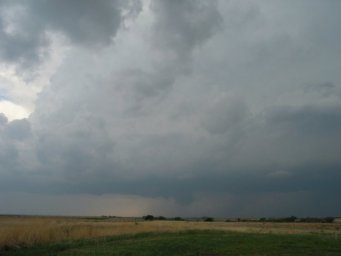 |
344 pm: cloud base lowerings
southwest of Gove. The storm developed a pronounced (if low contrast) wall
cloud as it continued west of Gove, with very strong ESE
inflow winds. As it reached I-70, the storm turned more northerly and
structure became messier.
|
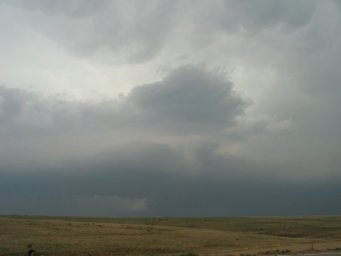 |
456 pm: same supercell now turning NNW
to the southwest of Hoxie KS. Cloud base structure had just recently
appeared to improve with a low-level meso/clear slot (as in photo)...
interestingly, right at the time I was preparing to abandon it and commit to a beefier supercell developing well to my south.
While en route, I bypassed an intermediate and
similarly pre-tornadic storm southwest of Grainfield on I-70; at the time
it had a distinct, non-rotating wall cloud with a
massive wall of rain encroaching behind it.
|
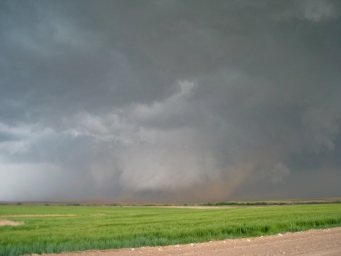 |
Taking Highway 283 south of
Wakeeney and then the Trego-Ness county line gravel road 12 miles west, I intercepted my target
storm about 6 miles northeast of Utica KS at 608pm. I was initially
surprised by the relatively high-based and linear structure. However, as I
headed north, rapid cloud base lowering beneath a classical RFD surge occurred
immediately to my northwest
(video only... captures forthcoming.) Within minutes, a violently rotating low-level mesocyclone was born, with an impressive train of RFD-driven
dirt blasting in front of it (615pm, as in photo... view looking NW). The dark mass beneath
the visible low-level meso contained a tornadic circulation intermittently
during the next several minutes, which WFOGLD
appears to have rated as EF-1 based on damage to a home and outbuildings.
|
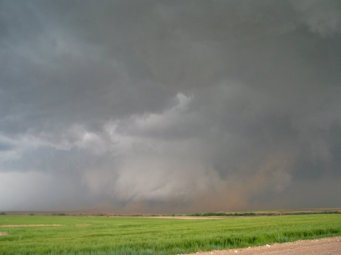 |
615pm: same.
The structure in this scene was somewhat reminiscient of the Hallam NE storm
during its first large tornado near Alexandria... four years ago to the day. |
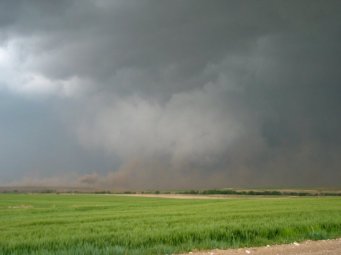 |
616pm: same.
Over the next couple minutes, the tornadic circulation became rain-wrapped
while my attention was diverted to a new tornado. |
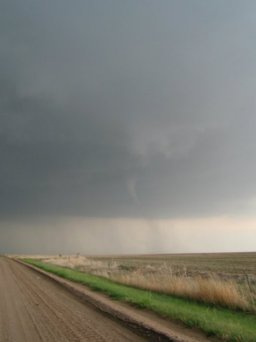 |
626pm:
the new tornado developed to
the ENE on the forward lip of the meso (view looking NNE)... a classical area for anticyclonic
spinups. The tornado persisted for four minutes,
with a fairly dramatic ropeout as the condensation funnel aloft tilted and a
substantial shower of dusty debris formed at ground level (video only). |
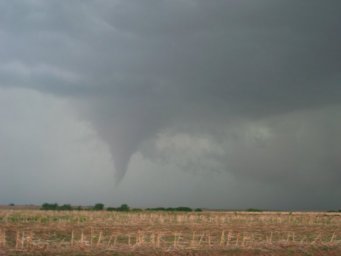 |
632 pm: a third
tornado developed back to the west, behind the primary meso. It lasted
about one minute. |
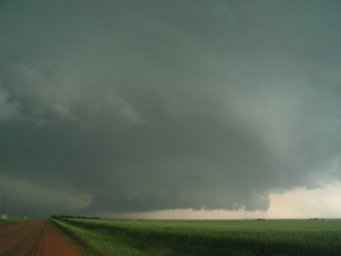 |
637 pm: while my attention had
been diverted to the previous two tornadoes, the primary low-level
mesocyclone rapidly re-emerged from the rain... larger and more low-based
than before. It had a rather incredible appearance as it began to
cross the road in front of me. The photo above shows my high-contrast
view of the meso after it had passed my longitude. Violent merry-go-round
rotation suddenly ensued, and a dusty tornado occurred for a couple minutes
beneath the leading (right-hand in photo) edge of the circulation. |
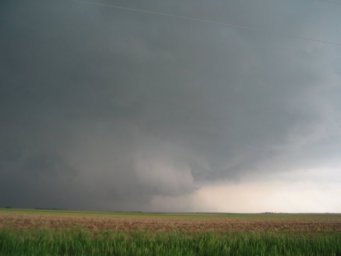 |
642 pm: I
turned east as a wet RFD surge rapidly overtook the low-level mesocyclone
(and nearly my car, too)... obscuring the tornado. I turned north
toward I-70, and over the course of the next 10 minutes the storm
transitioned into a typical HP supercell. |
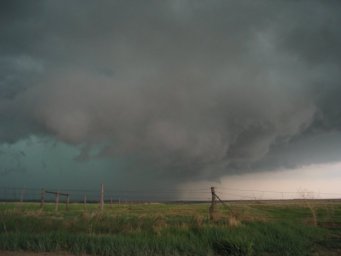 |
732 pm: same storm much later
northeast of Hill City. I dropped back south of Wakeeney and observed a
final tornado at darkfall with a new storm passing over Trego center. It
was a truncated cone around 8:48pm... lasting a minute or two just as
that storm transitioned to an HP as well. |

observed supercells

observed tornadoes (paths
estimated)

21Z
subjective surface analysis

modified
00Z DDC RAOB to represent Collier KS
Sfc
T/Td: 81/64 F
MLCAPE:
2940 J/kg
MLCINH:
3 J/kg
0-3 km
MLCAPE: 106 J/kg
MLLCL:
1381 m
MLLFC:
1491 m

modified
00Z DDC RAOB hodograph to represent Collier KS
storm
motion: 204 deg @ 35 kts
0-1 km
SRH: 297 m2/s2
0-3 km
SRH: 348 m2/s2
0-1 km bulk shear: 29 kts
0-6 km bulk shear: 63 kts
7-10 km SR flow: 20 kts